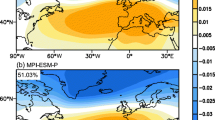Abstract
The natural variability of regional climatic conditions poses certain difficulties in detecting global climate change at a local scale. The question about the ratio between the contribution of human forcing, induced by the increase in atmospheric carbon dioxide concentration, and the contribution of natural variability in atmospheric and oceanic circulation arises in each particular case. The purpose of the study reported in this article was to evaluate the contribution of the North Atlantic Oscillation to the decrease in the climate continentality of Moscow during the period of 1951–2000. The results show that a significant part of the decrease in continentality could be attributed to the increase in the North Atlantic Oscillation index observed during this period.




Similar content being viewed by others
REFERENCES
G. A. Aleksandrov, A. S. Ginzburg, and G. S. Golitsyn, “Dynamics of the Gorchinsky index of continentality under climate changes,” in Turbulence, Dynamics of the Atmosphere and Climate (Fizmatkniga, Moscow, 2018), pp. 168–171 [in Russian].
G. A. Alexandrov, A. S. Ginzburg, and G. S. Golitsyn, “The negative correlation between the changes in Moscow’s continentality index and mean annual temperature,” in Earth and Environmental Science (IOP Publishing, Moscow, 2019), Vol. 231, no. 1, p. 012004.
A. S. Ginzburg, O. A. Reshetar, and I. N. Belova, “Impact of climatic factors on energy consumption during the heating season,” Thermal Eng. 63 (9), 621–627 (2016).
V. V. Klimenko, A. S. Ginzburg, P. F. Demchenko, A. G. Tereshin, I. N. Belova, and E. V. Kasilova, “Impact of urbanization and climate warming on energy consumption in large cities,” Dokl. Phys. 61 (5), 521–525 (2016).
V. V. Klimenko, A. G. Tereshin, and E. V. Kasilova, “Moscow: A natural testing area for strong warming impact assessment,” Dokl. Phys. 62 (11), 527–531 (2017).
I. N. Belova, A. S. Ginzburg, and L. A. Krivenok, “Heating seasons length and degree days trends in Russian cities during last half century,” Energy Procedia 149, 373–379 (2018).
S. P. Khromov and L. I. Mamontova, Meteorological Dictionary (Gidrometeoizdat, Leningrad, 1974) [in Russian].
W. L. Gorczynski, “The calculation of the degree of continentality,” Mon. Weather Rev. 50 (7), 369–370 (1922).
V. Conrad, “Usual formulas of continentality and their limits of validity,” Trans. Am. Geophys. Union 27 (5), 663–664 (1946).
S. P. Khromov, “On the problem of climate continentality,” Izv. Vses. Geogr. O-va 89 (3), 222–225 (1957).
B. V. Poltaraus and D. B. Staviskiy, “The changing continentality of climate in central Russia,” Sov. Geogr. 27 (1), 51–58 (1986).
J. Vilček, J. Škvarenina, J. Vido, P. Nalevanková, R. Kandrík, and J. Škvareninová, “Minimal change of thermal continentality in Slovakia within the period 1961–2013,” Earth Syst. Dyn. 7, 735–744 (2016).
S. N. Lapina, “Description of climate continentality in Saratov and St. Petersburg against the background of global warming,” Izv. Sarat. Univ., Ser.: Nauki Zemle 17 (4), 219–221 (2017).
A. V. Eliseev and I. I. Mokhov, “Amplitude–phase characteristics of the annual cycle of surface air temperature in the Northern Hemisphere,” Adv. Atmos. Sci. 10 (1), 1–16 (2003).
A. V. Eliseev, I. I. Mokhov, and M. S. Guseva, “Sensitivity of amplitude–phase characteristics of the surface air temperature annual cycle to variations in annual mean temperature,” Izv., Atmos. Okean. Phys. 42 (3), 300–312 (2006).
T. R. Karl, G. Kukla, V. N. Razuvayev, et al., “Global warming: Evidence for asymmetric diurnal temperature change,” Geophys. Res. Lett. 18 (12), 2253–2256 (1991).
P. F. Demchenko, G. S. Golitsyn, A. S. Ginzburg, and N. N. Vel’tishchev, “Assessment of the diurnal cycle of SO2 greenhouse effect according to one-dimensional models of the vertical structure atmosphere,” Izv. Ross. Akad. Nauk: Fiz. Atmos. Okeana 30 (5), 595–600 (1994).
R. Davy, I. Esau, A. Chernokulsky, S. Outten, and S. Zilitinkevich, “Diurnal asymmetry to the observed global warming,” Int. J. Climatol. 37 (1), 79–93 (2017).
S. Nigam, N. P. Thomas, A. Ruiz-Barradas, and S. J. Weaver, “Striking seasonality in the secular warming of the northern continents: Structure and mechanisms,” J. Clim. 30 (16), 6521–6541 (2017).
A. R. Stine and P. Huybers, “Changes in the seasonal cycle of temperature and atmospheric circulation,” J. Clim. 25, 7362–7380 (2012).
K. A. McKinnon, A. R. Stine, and P. Huybers, “The spatial structure of the annual cycle in surface temperature: Amplitude, phase, and Lagrangian history,” J. Clim. 26 (20), 7852–7862 (2013).
V. A. Semenov, M. Latif, J. H. Jungclaus, and W. Park, “Is the observed NAO variability during the instrumental record unusual?,” Geophys. Res. Lett. 35, L11701 (2008).
E. S. Nesterov, The North Atlantic Oscillation: Atmosphere and Ocean (Triada, Moscow, 2013) [in Russian].
C. Deser, J. W. Hurrell, and A. S. Phillips, “The role of the North Atlantic Oscillation in European climate projections,” Clim. Dyn. 49, 3141–3157 (2017).
O. N. Bulygina, V. N. Razuvaev, N. T. Trofimenko, and N. V. Shvets, Description of the database of monthly-mean air temperature at Russian stations. http:// meteo.ru/data/156-temperature#oпиcaниe-мaccивa-дaнныx. Accessed March 12, 2017.
J. H. Lawrimore, M. J. Menne, B. E. Gleason, C. N. Williams, D. B. Wuertz, R. S. Vose, and J. Rennie, “An overview of the Global Historical Climatology Network monthly mean temperature data set, version 3,” J. Geophys. Res. 116, D19121 (2011).
J. Hurrell, The Climate Data Guide: Hurrell North Atlantic Oscillation (NAO) Index (station-based), Boulder, USA (2018). https://climatedataguide.ucar.edu/ climate-data/hurrell-north-atlantic-oscillation-nao-index-station-based
V. A. Semenov, “Influence of oceanic inflow to the Barents Sea on climate variability in the Arctic region,” Dokl. Earth Sci. 418 (1), 91–94 (2008).
G. A. Aleksandrov, “Towards the choice of the generic indicator for monitoring ecoclimatic changes,” Probl. Ekol. Monit. Model. Ekosist. 28 (1), 73–82 (2017).
ACKNOWLEDGMENTS
We are grateful to reviewers for their careful reading of the manuscript and helpful remarks.
Funding
This work was supported by the Russian Science Foundation, project no. 16-17-00114.
Author information
Authors and Affiliations
Corresponding author
Additional information
Translated by V. Selikhanovich
Rights and permissions
About this article
Cite this article
Alexandrov, G.A., Ginzburg, A.S. & Golitsyn, G.S. Influence of North Atlantic Oscillation on Moscow Climate Continentality. Izv. Atmos. Ocean. Phys. 55, 407–411 (2019). https://doi.org/10.1134/S0001433819050025
Received:
Revised:
Accepted:
Published:
Issue Date:
DOI: https://doi.org/10.1134/S0001433819050025




